5 Essential leadership presentation ideas to master

Leaders are foundational for any organization’s growth. Good leadership can bring teams together and can drive an entire organization’s growth.
Effective leadership results from various stakeholders coming together and guiding talented individuals onto the right path. Executive and senior management also play a crucial role in the training and development of leaders.
This article dives into some key skills for effective leadership, leadership team-building activities, and leadership presentation topics that can be used to build rapport with employees.
What are the key skills required for effective leadership?
Leaders have the toughest jobs, i.e., not only do they have to ensure projects meet deadlines but they also have to ensure that employees can thrive in an organization.
Even leaders need a bit of support to grow into their roles. This is where the executive management’s role in the training of leaders becomes very crucial. Having walked a similar path, the executive management team has the experience to enhance the performance of new leaders and empower them with tools and resources to perform better. Newly promoted leaders need a bit of hand-holding by executive management to show them the best ways to flourish professionally.
Below are the key leadership skills required for effective leadership:
Communicating with teams
One of the key traits that leaders need to have is strong communication and effective presentation skills.
Communicating with the team helps in:
- Creating rapport and trust
- Team building and coordination
- Keeps the leader and the whole team updated on the status
Not just strong skills but also adaptive and effective communication skills. Senior executives can help newly appointed leaders by sharing the best practices examples and organizing training programs. Seasoned leaders can enhance their skills with advanced leadership training sessions and improve upon their communication with their teams.
Leaders need to create an environment where employees can communicate their requirements to perform well in their roles. Additionally, creating a strong rapport with the team can help employees approach leaders easily. For example, they can trust the leader to freely share their ideas, ask for career advice, seek support when required, and/or even rely on the leader when faced with very tough challenges.
Managing people and projects
Working on their core job, drafting executive reports, executing projects, managing teams and their performance, and so much more can be overwhelming for anyone. The following points are key in maintaining a good rapport with teams and to ensure smooth project delivery.
- Communication: An effective communication plan can help all stakeholders to be on the same page about projects and their progress. Clear and concise communication to teams, can improve efficient completion of tasks within requisite timelines.
- Transparency: Being transparent with your team members about the project's progress, potential risks or challenges, and any setbacks, can help build strong working relationships.
- Professionalism: Every project and collaboration brings forth different ideas and inputs to complete the task efficiently. It might yield some disagreements, but leaders need to maintain a balanced communication style to ensure the successful completion of projects.
Resolving conflicts
When individuals from different backgrounds and work experiences come together, there is bound to be conflict. Disagreement on strategies and opposing ideas in a project is part and parcel of leading a team.
This can be a huge hurdle if leaders aren't equipped with resources to resolve conflict.
Some important things for leaders to keep in mind are:
- Decipher the root cause of disagreements: Disagreements between teams arise due to a mismatch in their work requirements, their ideas being ignored, or having too much on their plate to work efficiently, and several other reasons. When leaders understand the root cause of disagreements between team members, it becomes much easier to resolve issues and ensure that teams are equipped to communicate better and work well together.
- Identify patterns of conflicts: Conflicts arising occasionally are normal but if there is a regular occurrence, it is a major problem. Suppose a similar problematic situation arises more than two times– in that case, leaders need to keep a check, use communication tactics to resolve conflicts, and if required, take authoritative action to keep things in check.
- Anticipate and prepare for conflicts: Conflicts are inevitable in any workplace setup. Instead of being averse to the idea, being able to anticipate some of the workplace problems, can equip leaders to course correct in the early stages of dissidence.
Executive or senior management teams have often seen their fair share of conflicts. They also have experience in resolving issues harmoniously. Seniors can offer practical advice and provide insights into conflict resolution. Having open conversations with senior members of the organization can provide a great learning experience for all leaders.
Leading under pressure
As the leaders step into higher roles, their responsibility also increases. This also means that leaders have to perform well, succeed at their jobs, and manage their teams.
This can be daunting for any individual. Stress can adversely affect the health of an individual and built-up stress could trickle down to an unintended exchange of words with others at work. To avoid tricky situations at work, the SCARF Model in leadership and coaching can help. What is the SCARF model?
- Status: Appreciate and recognize team members' skills and contributions. Constructive feedback and discussion of growth opportunities build a positive environment.
- Certainty: Leaders must communicate all the goals and expectations. Addressing concerns and regular updates helps reduce ambiguity.
- Autonomy: Flexibility in work processes provides room for creativity. Empower your teams with decision-making skills to take projects ahead.
- Relatedness: Help your team to build strong interpersonal relationships. A sense of camaraderie keeps teams together
- Fairness: Have transparent conversations, work allotment and decision-making. Create protocols and guidelines for dispute or conflict resolutions.
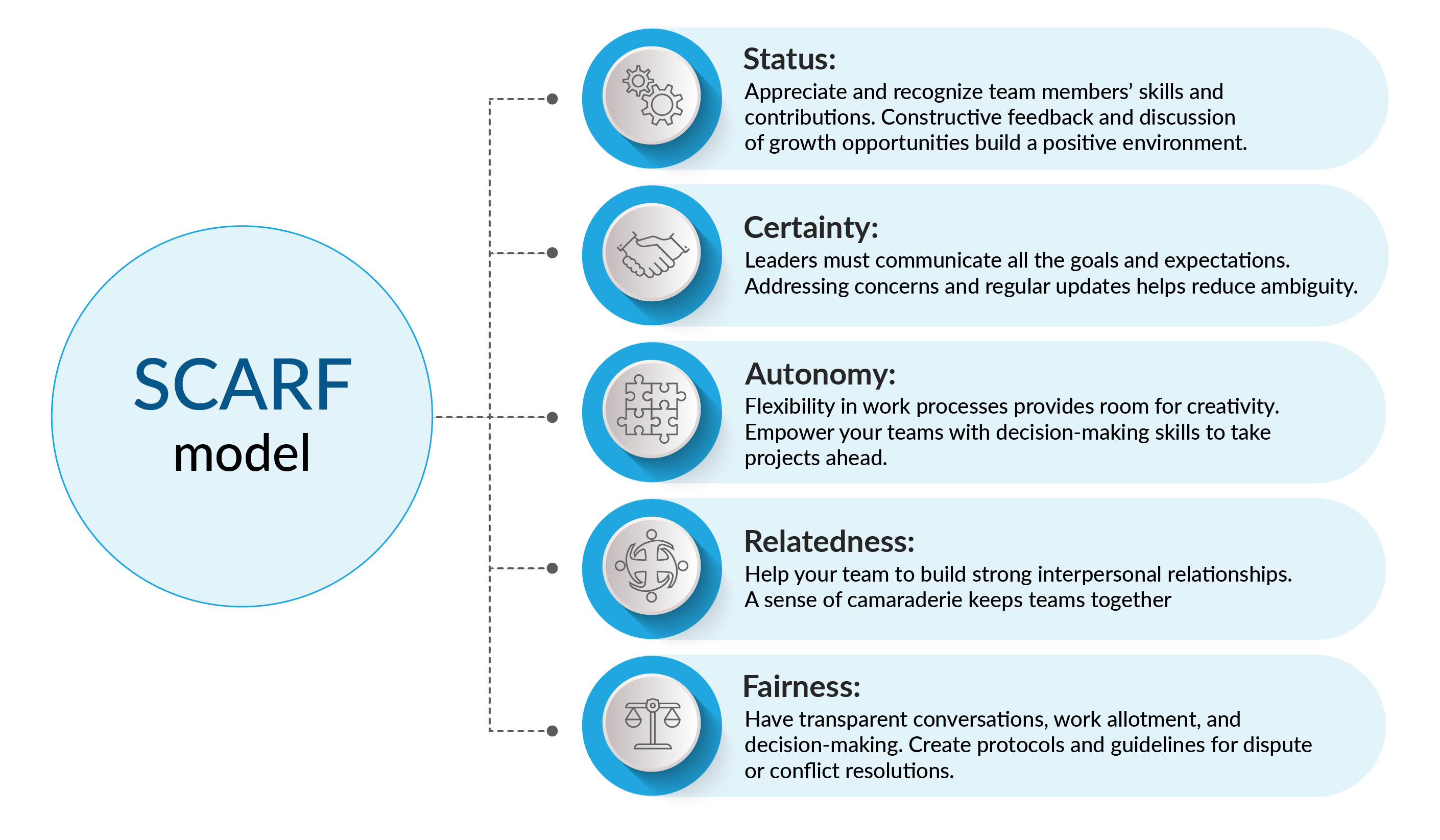
Senior management can train the leaders and show them the ropes of leading teams well under pressure. Having regular leadership meetings, creating new channels for engagement, sharing experiences, encouraging discussions amongst team leads, etc., by the seniors can help build a great support system for leaders.
Additionally, seniors could use presentations that showcase the best practices examples, different leadership styles, crisis management case studies, resolution techniques, etc., to help leaders manage their stress in the work environment.
Why are leadership team-building activities important?
Great leadership is not just about effective communication and awe-inspiring presentations but it is also about ensuring that employees are passionate about their jobs and motivated to work.
In addition to honing their skills, leaders must invest their energy into setting the company culture, building teams, helping employees develop their interpersonal skills, and so much more. Discussions with all stakeholders and consensus from teams and individual members can boost efficiency and productivity at work.
Internal team discussions can help create the right team-building activities! Getting inputs on their preferences, schedules or any other information can better help craft professional and fun team-building activities. From weekly ‘Friday-fun meetings’ to ‘Monthly-beats’ to even off-site workshops/events, all such activities can help employees build rapport with each other and improve efficiency and productivity at work.

What are the basic leadership presentation topics?
The role of leaders is not just limited to the business aspect but also to create an environment for the growth and success of the employees and teams. Managers can create a positive work environment through balanced performance reviews, managing change effectively, helping their teams with training and development, and much more.
While there is a comprehensive list of topics to choose from, leaders could look into the following basic presentation topics to improve employee engagement.
1. Performance management
Feedback can motivate employees to improve their performance and even follow their leaders in the future. Leaders must be well-versed in providing feedback on employees’ work and their performance. The following points can help provide better feedback and build professional equations at work.
- Create impactful presentations
- Define goals and objectives clearly
- Understand your audience
- Have a cohesive content flow
- Ensure impactful visuals
- Encourage employee interaction
Craft a good performance management deck with the steps above and captivate your teams. Leaders and the teams can get together to discuss the frequency of such meetings (monthly, quarterly, or half-yearly), clarify the team KPIs, discuss holistic team performance, etc. Creating a schedule for active participation with inputs from all team members can help them grow in the organization.
Performance presentation template: These templates will help you to evaluate and communicate the performance metrics effectively. Use these downloadable performance presentation templates to ease the understanding of the progress and goals to match by the next performance review.
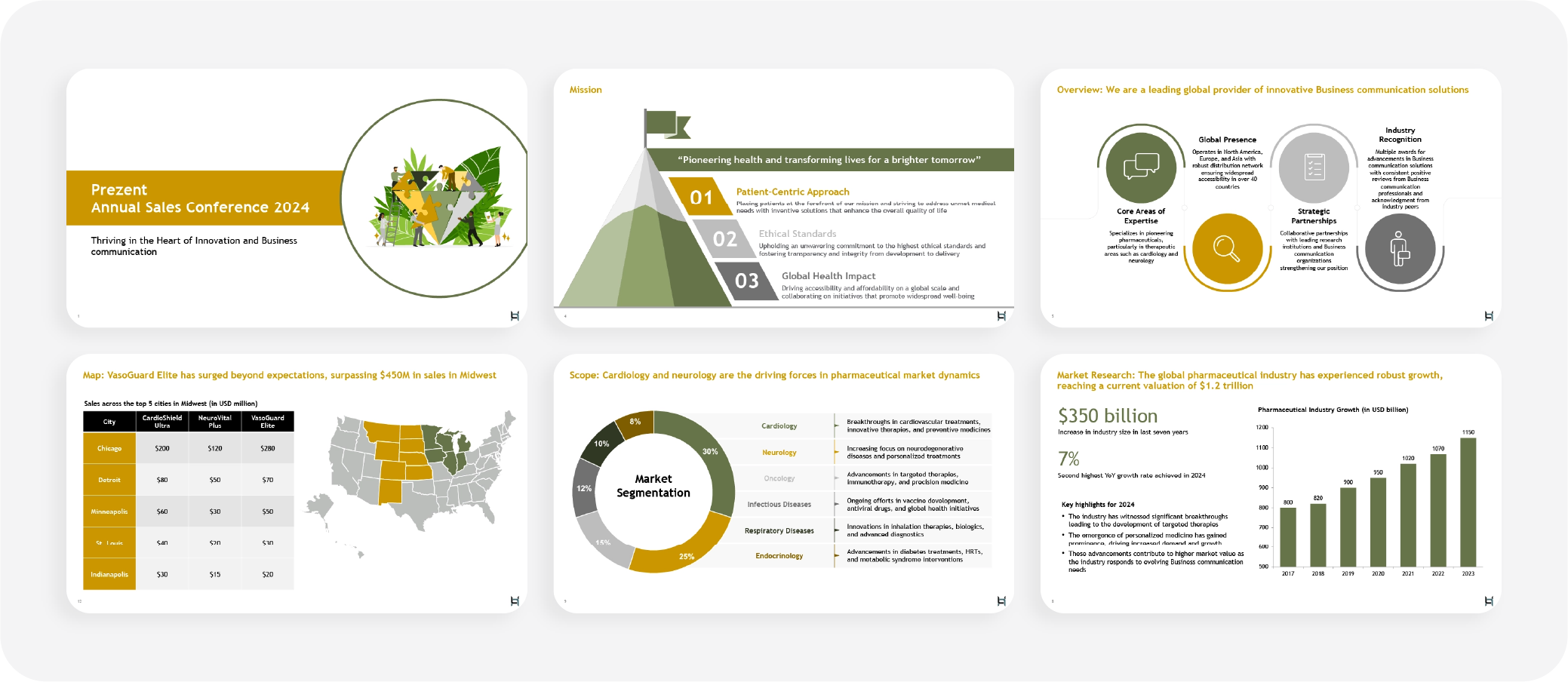
2. Change management
Change is inevitable in this fast-paced tech era and adapting to the changes can be tough for all leaders – be it a seasoned leader or new leaders in the workforce. Leaders should be able to deal with new challenges in the industry without disrupting team workflow.
Communicating the potential changes with teams and ensuring everyone is on the same page about such variations can better equip the employees to adapt to any new organizational developments. Some of the ways leaders can enable teams to adapt to change better are:
- Plan meetings
- Use case study presentations
- Start discussions or use training topics
- Utilise records of the past
- Discuss trending topics of the present
Change management presentation template: Use these change management presentation templates to structure a framework, facilitate communication of changes to employees, and ensure a seamless transition.
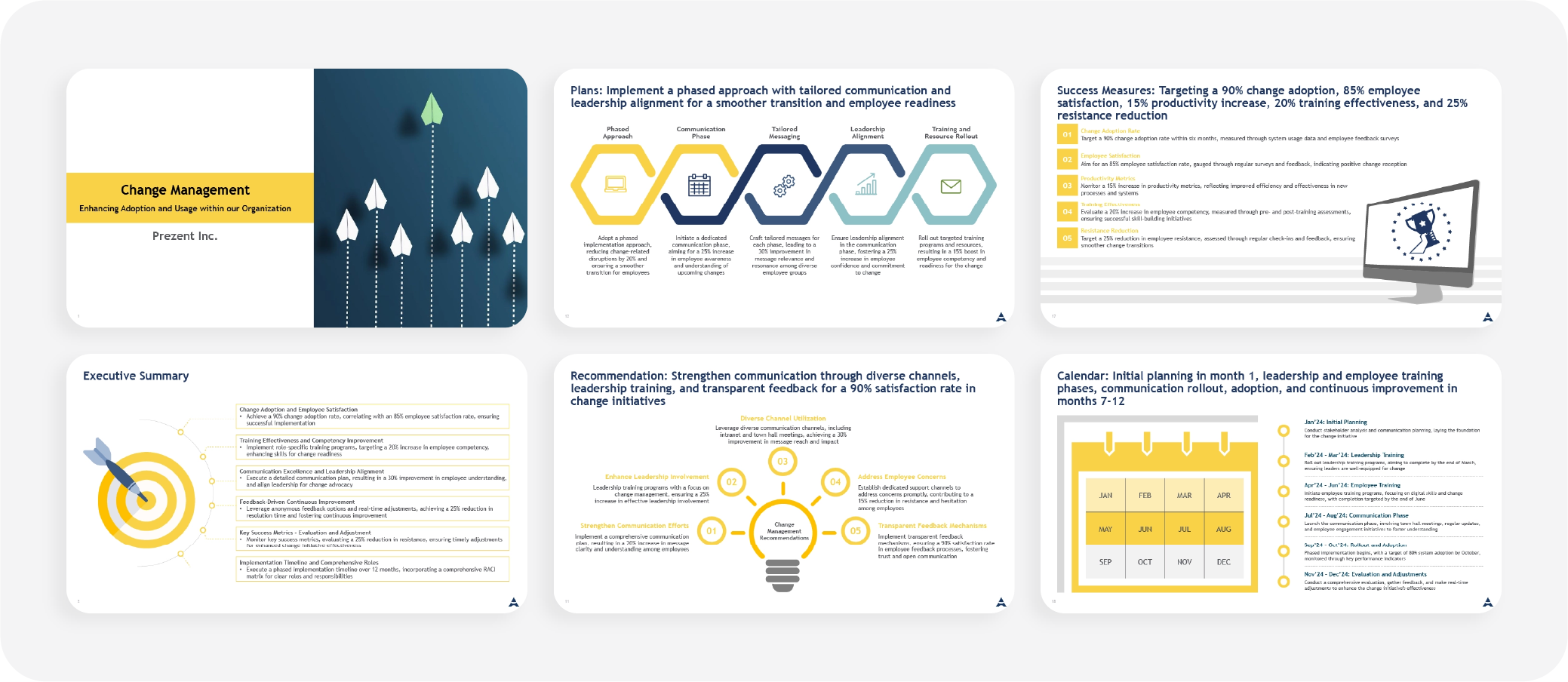
3. Training & development
Investing in your employee's growth and success is an investment that yields results in the form of long-term employee retention. Having some engaging presentations can drive the training and development in the right direction.
- Start your presentations with a hook and keep them engaged with a compelling storyline
- Customize the slides based on your audiences and present your work to resonate with the various attendees of the presentation
- Have slide breakers or interactive Q&A slides that take away from the monotony of technical details
- Ensure brand-aligned designs and messages to encourage teams to follow a similar path for effective presentation delivery
Training and development presentation template: The following training and development presentation templates can help facilitate knowledge sharing, skill development, and the overall enhancement of individual capacities among employees.
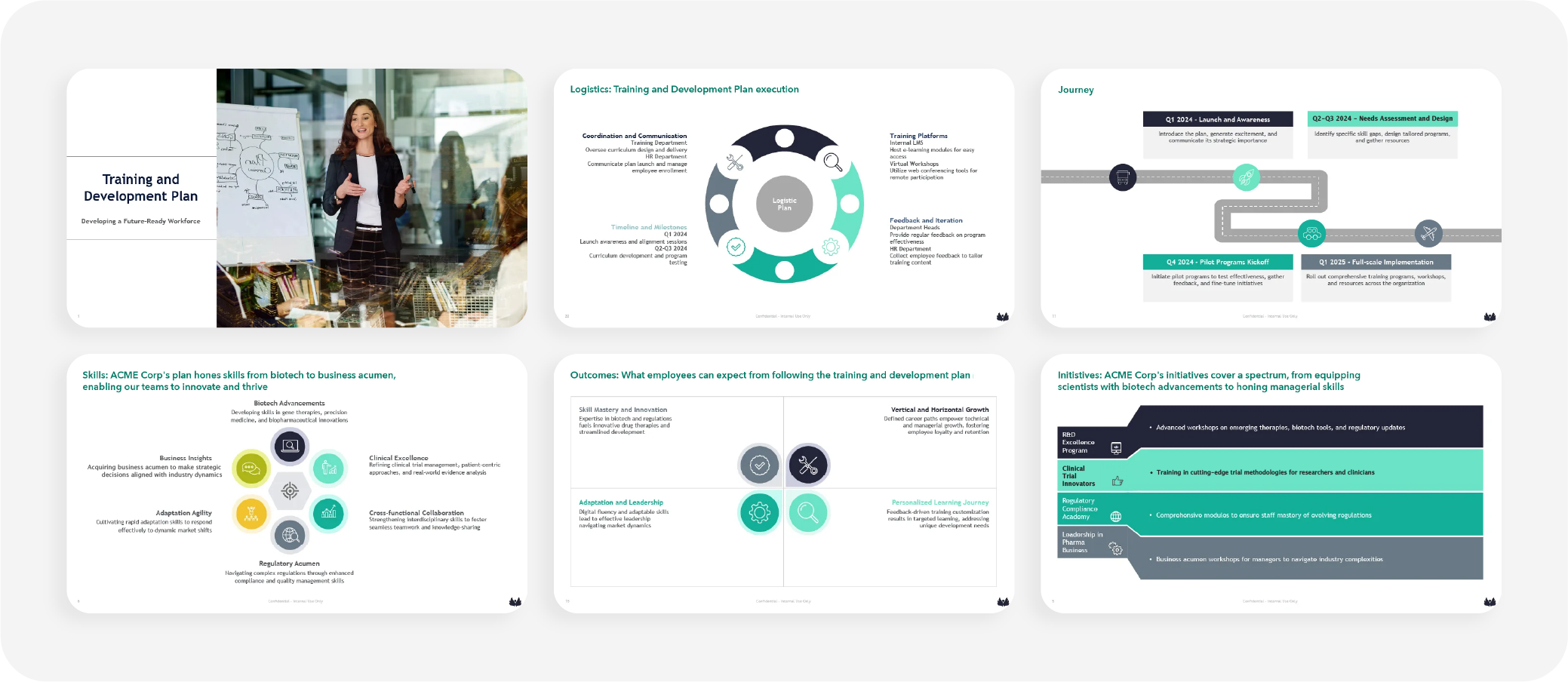
4. Rewards and recognition
At the end of the day, employees look forward to appreciation, be it a small spot award or a big yearly recognition. Leaders could also use the following presentation topics to improve employee engagement:
- Create an internal awards system for teams and schedule a meeting to showcase employees' achievements in that quarter or month
- Bring teams together by sharing short snippets of team members either during their work anniversaries or important milestones in their careers
- Schedule birthday celebratory slides in the organizations to improve personal engagement at work
Rewards and recognition presentation templates: You can utilize the rewards and recognition presentation templates to build a comprehensive framework such as program objectives, criteria for recognition, types of rewards, and program implementation strategies.
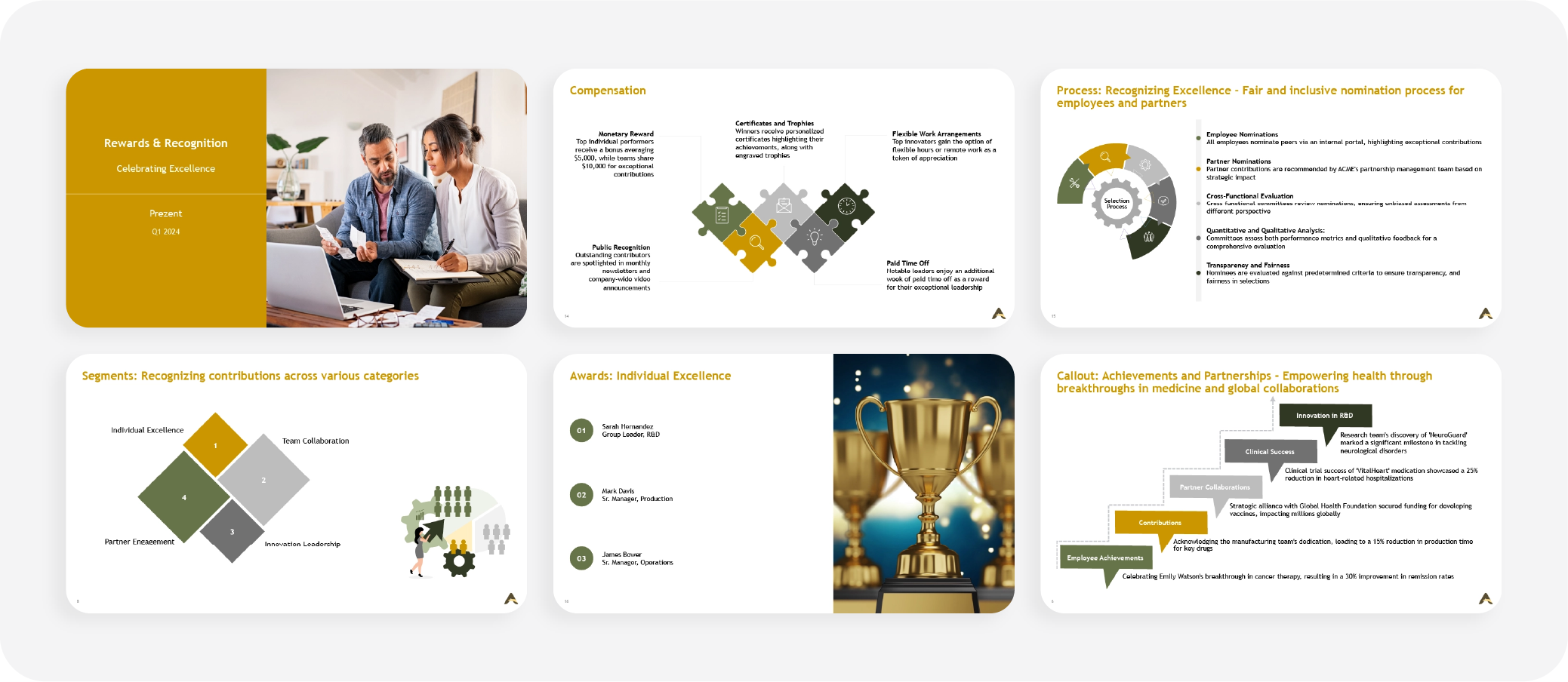
5. Soft skills training
Soft skills are traits that anyone can hone over time and for leaders, improving their soft skills and that of their teams is vital for working together. It is important to work on soft skills to grow in the professional space. Some of the main skills that every individual needs to work on and some of the topics that leaders could present are:
- Time Management
- Interpersonal communication
- Critical thinking skills
- Self-motivation
- Analytical skills
- Empathy
- Attention to detail
- Adaptability
- Problem-solving skills
- Integrit
Soft skills training presentation templates: These downloadable soft skills training presentation templates offer professionally designed slides. The focus can be directed toward interactive activities, case studies, and role-playing exercises to reinforce learning and application.

How Prezent can enable effective leadership training?
Prezent is a powerful business communication tool that not only helps you craft professional-looking presentations in 50% less time but also empowers you and your team with refined communication skills. Prezent can enhance leadership communication skills with the following features:
- Courses: Prezent offers extensive learning courses designed to improve your communication skills. These courses are thoughtfully curated, breaking down each section into bite-sized videos that are easy to understand, retain, and follow up on in your free time.
- Story Builder: This ready-to-use platform feature provides 1000+ expert-curated storylines. Choose slides as per your requirement and have more engaging conversations with your teams.
- Best Practice Library: Provides access to over 10,000 curated slides and presentations. These resources cover a variety of roles and functions, providing invaluable guidance on your projects.
You can explore many incredible features of Prezent that can help you ensure effective leadership training. To learn more about Prezent, you can opt for a free trial or schedule a demo with our experts.












.jpg)
